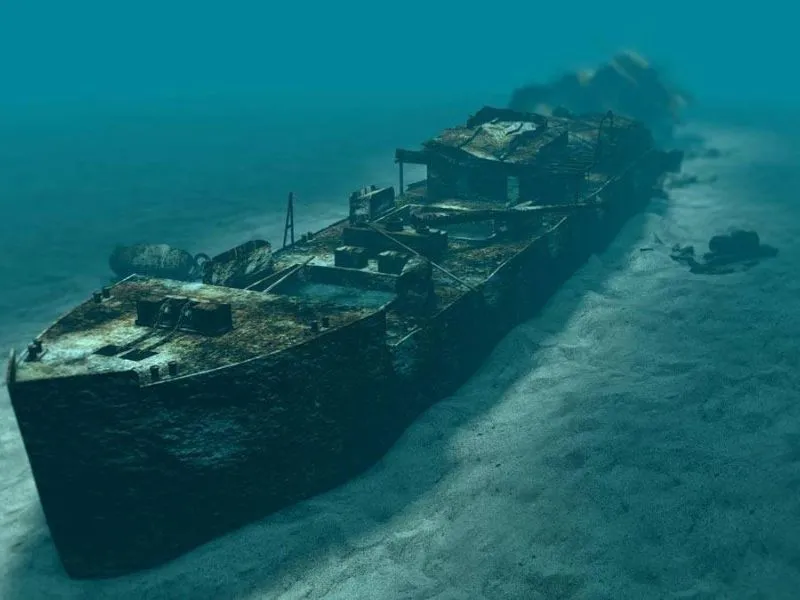The SS Thistlegorm Wreck is one of the most famous dive sites in the world, located in the Red Sea near the coast of Egypt. This British merchant navy ship sank in 1941 after being bombed by German planes during World War II. The wreck is now an artificial reef and home to various marine life, making it a popular spot for divers and historians alike.
History of SS Thistlegorm Wreck
The SS Thistlegorm wreck, located on the west coast of the Sinai Peninsula and only 40 km from Sharm El Sheikh, is the most well-known and popular wreck dive site in the Red Sea. It is perfect for beginner and advanced divers looking for an exciting adventure. This British army freighter was launched in April 1940 and sunk 18 months later during World War II after being loaded with wartime supplies, including tanks, aircraft, armoured vehicles, Jeeps, and Bedford trucks.
Despite being privately owned and operated, the SS Thistlegorm was fitted with a 4″ anti-aircraft gun and a heavy-calibre machine gun for war duty. The ship’s final resting place is 30m deep on the sandy seabed, where she lies upright with her stern section separated from the main body by 20m.
Jacques Cousteau rediscovered the wreck in 1956, and it has since become the most sought-after scuba diving wreck in the world. It is believed that the Thistlegorm is the most frequently dived site globally, and it is easy to see why. The holds contain World War II relics such as BSA motorbikes, Morris automobiles, Bedford trucks, trailers, armoured cars, Lee Enfield rifles, bombs, munitions crates, grenades, anti-tank mines, spare parts for tanks and planes, and even Wellington boots.
The wreck is 125m long, and it takes two days of diving to orient yourself to the site’s vastness. Divers can explore the bow section by descending onto the main deck area at 15m and entering Hold no.1 from a prominent square entrance on the floor near the main anchor chains. The holds have two levels, and it is possible to swim through the wreck from Hold 1 to 3, using the internal interconnecting doorways at a maximum depth of 25m.
Amidships is where you can see the full force of the devastation that took place. The hull has been peeled back by the explosions, revealing large boxes of ammunition shells and artillery lying among the SS Thistlegorm’s mangled wreckage. You can also see many lionfish here, and schools of blackspotted sweetlips take shelter from the currents.
Towards the stern, two machine guns on turrets hang precariously over the port side where the stern has listed. The ship’s large propeller is easily identified once you swim around the rear of the ship at 32m. As you make your way back up and across the top of the Thistlegorm nearing the end of your dive, you’ll find a lively marine scene. Orange-spotted and Heber’s trevally hunt schools of fusiliers, large schools of their batfish follow scuba divers around, crocodile fish lie hidden on the deck floor, and a hawksbill turtle or two brush past in search of food.
It is best to dive the wreck in the early morning from a liveaboard boat before the daily boats arrive and turn the site into a busy diver’s haven. The SS Thistlegorm remains the Red Sea and Sharm El Sheikh’s foremost scuba attraction, attracting so many divers daily that air pockets are trapped against the ceilings of some of the holds. Don’t miss out on the opportunity to explore this historical wreck and experience the thrill of diving in a living museum.
Diving in SS Thistlegorm Wreck
The SS Thistlegorm Wreck is a must-see for any experienced diver looking for an adventure. The wreck lies at a depth of 30 meters and is accessible by boat from the coastal town of Sharm El Sheikh. Divers should be comfortable with deep diving and have their wreck diving certification.
Once at the site, divers can explore the wreckage, which is still relatively intact, with its cargo of trucks, motorcycles, and even locomotives lying in the hold. The site offers a unique opportunity to experience a piece of history and get up close to the wreckage of a World War II ship.
Marine Life at SS Thistlegorm Wreck
Over the years, the SS Thistlegorm Wreck has become an artificial reef home to diverse marine life. Schools of fish, including barracudas, snappers, and groupers, can be seen swimming in and around the wreckage. Divers can also spot moray eels, lionfish, and even sea turtles.
Liveaboard trips to SS Thistlegorm Wreck
Liveaboard trips to the SS Thistlegorm Wreck are popular for divers who want to explore the site in more detail. These trips typically include multiple dives over a few days, allowing divers to experience the area at different times of day and explore other parts of the wreckage.
Conclusion
The SS Thistlegorm Wreck is a unique and exciting dive site that offers a window into history and provides a home for various marine life. It’s a must-visit for experienced divers looking for an adventure and a chance to explore a piece of World War II history. With liveaboard trips available, it’s easier than ever to plan a trip and experience the SS Thistlegorm Wreck for yourself.
Where is Thistlegorm Wreck?
SS Thistlegorm is located north of The Red Sea, near the mouth of The Gulf of Suez. The nearest point of land is 9 kilometers to Thistlegorm’s northeast. Still, the most immediate area of development (Sharm el Sheikh) is a 40-kilometre journey around the peninsula of Ras Mohamed Nature Reserve.
Frequently Asked Questions for SS Thistlegorm ShipWreck
The SS Thistlegorm Wreck is suitable for advanced divers or equivalent, and it's recommended to have an advanced open water certification or equivalent.
Yes, it's recommended to bring a dive flashlight when diving at the SS Thistlegorm Wreck. The interior of the wreck can be dark, and a light is necessary to see the details of the wreckage and any marine life hiding within.
SS Thistlegorm Wreck is an incredibly popular dive site due to its rich history and fascinating array of artifacts. Divers can expect to see the remains of the ship, which was carrying supplies for British troops during World War II when it was sunk by German bombers. The wreck is now home to a variety of marine life, including barracuda, jackfish, and turtles.
Divers can also explore the cargo holds, where they can see trucks, motorcycles, and even railway carriages that were being transported by the ship. It's essential to approach the wreck with respect and not disturb or remove any artifacts.
Most liveaboard trips offer two dives at the SS Thistlegorm Wreck, and it's highly recommended to dive with a guide who is familiar with the site's currents, entry and exit points, and safety procedures.
The SS Thistlegorm Wreck can be dived year-round, but the best time to visit is from April to June or September to November, when the weather is generally calm, and the water temperature is comfortable.
The SS Thistlegorm Wreck can only be reached by liveaboard, and most liveaboards depart from Hurghada. The exact departure point and schedule will depend on your chosen liveaboard Boat.
You will need to bring or rent proper diving equipment, including a wetsuit, fins, mask, regulator, buoyancy compensator device (BCD), dive computer, and torch. It's recommended to have your own equipment, but it can also be rented on request
The SS Thistlegorm Wreck lies at a depth of around 30 meters (100 feet) and can be seen from the surface on calm days. Visibility can vary depending on the time of year and weather conditions, but it's generally good with a range of 20-30 meters (65-100 feet).
Safety procedures for diving at the SS Thistlegorm Wreck include diving with a guide, using a dive computer, monitoring your air supply, and practicing reasonable buoyancy control. Bringing a surface marker buoy (SMB) and following the buddy system is also recommended.
Yes, underwater photography and videography are allowed at the SS Thistlegorm Wreck. However, it's important to respect the marine life and artifacts and not touch or disturb them in any way.
Yes, the SS Thistlegorm Wreck is a popular site for technical diving, but it's only recommended for experienced technical divers with the appropriate certification and training.
The SS Thistlegorm Wreck is home to diverse marine life, including schooling fish, barracuda, tuna, jacks, and reef sharks. It's also common to see octopus, moray eels, and a variety of colorful reef fish.
REQUEST YOUr TRIP
to SS Thistlegorm Wreck
-
Included
● 2 Meals & soft drinks● Tanks & Weights● Dive Guide
-
Exclude
● 15L Tanks● Nitrox● Dive Computer & Torch
You may also like
- CATEGORY: - North -, Red Sea Dive Sites

